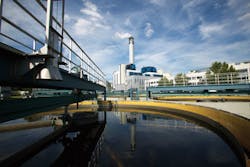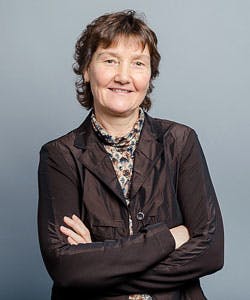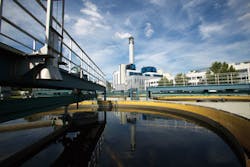Keeping Berlin Ahead of the Curve
As one of Germany’s largest water utilities, Berliner Wasserbetriebe is now embracing digitisation to move its operations to a Water 4.0 model. WWi caught up with Regina Gnirss, head of research & development at the utility to find out more.
By Tom Freyberg
As one of Germany’s largest water utilities, Berliner Wasserbetriebe provides 3.7 million people in Berlin and Brandenburg with drinking water, as well as collection and advanced biological wastewater treatment. The utility has always been progressive when trying to generate its own energy. Currently, 70 percent of the energy required to operate its six wastewater treatment plants is generated from biogas and sludge. Since the end of 2012, three wind turbines at the Schönerlinde wastewater treatment plant (WWTP), each with an output of two megawatts, has meant the site now has a self-sufficient energy balance.
Berlin now has 221 km2 of water protection zones, accounting for 25 percent of the city area. A total of €5 billion investment since 1990 has meant that 81 percent less phosphorous and 98% less ammoniacal nitrogen are being discharged into the Spree and Havel rivers.
Following such advancements, Berliner Wasserbetriebe has now turned its attention to the digitisation of its drinking water sources. WWi magazine caught up with Regina Gnirss to find out more.
WWi: Berliner Wasserbetriebe is looking at the entire water cycle and trying to progress to what is being called not only Industry 4.0 but Wasser 4.0. Let’s start with your work on improving groundwater efficiencies?
Regina Gnirss, head of research & development at Berliner Wasserbetriebe (RG): We have 650 production wells to extract the drinking water but this also means 650 wells to observe the water quality. To do that we need a lot of sensors and equipment to generate models telling us not only about the quantity of water but the quality. We are now able to measure trace organics and salt concentrations. We are doing the research work in cooperation with closely with universities, which is where the Water 4.0 comes in.
WWi: With all this data you can measure the increase recharge of the groundwater, as well as extraction and consumption and how that ties together?
RG: On one side we are monitoring how we are affecting the water table in the ground. Aquifer recharge is a major issue in our research field because if you introduce water into the ground, you have to make sure the quality is what you need. Using biomodelling, we are also able to predict how much water we can consume so as to not lower the water table. This is one of the tasks we have our operation team focused on.
WWi: That’s more on the drinking water side - the start of the cycle. Tell me about your journey to create self-autonomous wastewater treatment, including energy efficiency?
RG: On one side the wastewater treatment plants consume a lot of energy by aeration of biological processes. On the other side we manage to be more efficient by using better equipment and more sensors, such as oxygen sensors to control to a very low limit. We also have methane production and we are able to recover phosphorus from our sludge. We are looking forward to increase the renewable energy in our plants.
WWi: We’re seeing that elsewhere in Europe, such as in Denmark which was a self-sufficient wastewater treatment plant that produces more energy that it uses. I want to ask what is Wasser 4.0? Is this just a buzzword, or is the utility actually achieving it now?
RG: It’s not a buzzword - it’s a task for the future. We are not fulfilling it yet but together with the technical university we are employing professors only in the field of digitisation and we like to introduce sensors where we can monitor the water quality in the pipes on each point of the network. The network is 7,900 km and it’s a long way from our water plant to the customer. On this side of the business we have a lot of sensor development. In the security field - if there is a terrorist attack, we want to know immediately where that happens and we can model the distribution within the network. We are really looking forward to future topics and we manage these on a demonstrator level - so we have the whole network in our demonstrator and research field with the aim to eventually introduce these developments in reality.
Regarding pumping water station developments - from one pumping station we can control all of the 150 other stations. In the future we will probably be able to do our job with less people because the sensors will manage to give us a better idea of how we distribute the water/wastewater to existing plants.
WWi: You mentioned about having more sensors in the network. Presumably this would come at an increased cost to retrofit the pipes with more sensors?
RG: It’s not a question of many sensors. At the moment we are looking at distinct points where you need a sensor. We’ve reached the conclusion that to monitor the network and have the best pressure within the city, we need 50 sensors.
WWi: For the entire 7,900 km network?
RG: Yes, what we want to do is measure the quality. It will be also distinct points where we put the sensors. We cannot allow too many sensors as the cost will rise dramatically. You have to monitor their operation and clean them - that’s not the idea here. It’s a task to use as less monitoring equipment as you can to know what happens in reality and to take measures to operate accurately. We are developing well in this regard but we are not at the end.
We also try to predict stormwater events coming into the city. So about four hours before the stormwater starts, we have to pump the water to the wastewater treatment plants to be prepared to allow storage in your networks. Again, it’s not about having 10,000 stormwater sensors. You can imagine every cyclist has a sensor on his smartphone - then he gives you the idea whether it’s raining or it’s not raining. So we also like to have public engagement included in our monitoring system. That’s a few items we are doing in our research that will help us reach Water 4.0.
Tom Freyberg is chief editor of WWI magazine.
Fast facts: Berliner Wasserbetriebe
Employees: 4,355
Drinking water: In 2016 a total of 210 million cubic metres pumped from 650 groundwater wells using nine waterworks. Water flows through a 7,900 km network to reach 276,000 building connections in Berlin.
Wastewater: 244.9 million cubic metres treated at six WWTPs in 2016, transported by 150 pumping stations. 9,699 km of sewer networks and 1,180 km of force main networks.
Water protection zones: 221 km2
Total operating income (2016): €1.2 billion
More Water & WasteWater International Archives Issue Articles


